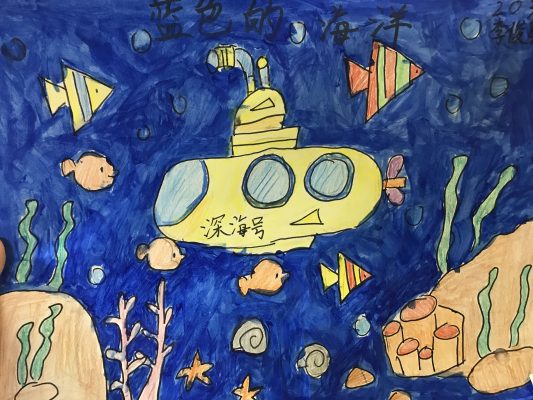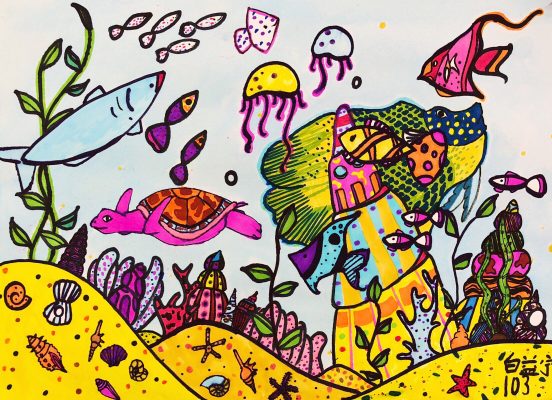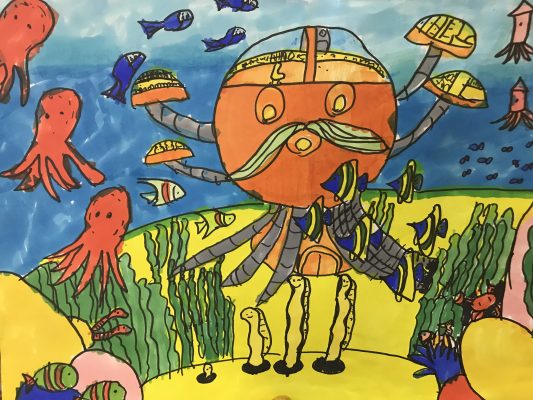Science can be thought of as a plant. If children are excited by science at a young age, there is the hope that they will continue on to become scientists in the future.
With today being Children’s Day, Southern University of Science and Technology (SUSTech) worked with the Popularization of Science group at SUSTech to find out what the children at the SUSTech Kindergartens and Primary Schools think about the ocean.
Children have long found the ocean to be a mysterious place of infinite imagination. There is no concept of how big it is. Later, they hear of “20,000 Leagues Under the Sea,” and want to know of this incredible location. Children wonder about whether or not mermaids truly exist, and if they can follow Nemo and Dora along their journeys.
As we grow up from young children, and develop into adults, our knowledge of the world under the ocean increases, as do the number of questions. The seabed has innumerable marine animals, ever-present microbial life, beautiful coral, rich deposits of resources and spectacular trenches. Despite our belief that the sea is calm beneath the surface, this is not the case, with underwater volcanoes potentially causing tsunamis that affect life elsewhere.
Of course, the questions of a child are pure and innocent. When they are met by the knowledge of a scientist, it is the scientist that must reassess their thinking to encourage children to head into the sciences, to spark their interest in the same or similar ways that they were interested in their own field.


Children at the SUSTech Kindergarten asked a lot of questions about the ocean, so the Department of Ocean Science and Engineering (OSE) was specifically asked to provide answers for the children. Head of OSE Chen Yongshun started by talking about why humans did research on the ocean, explaining that while we know a lot about the land, we know very little about the ocean. Deputy Director Xu Jingping added that some submarines can go as deep as 7,000 meters and that he had been in one of those manned submarines that had been that deep.
Professor Liu Qingsong answered many questions for the children. As the head of the Popularization of Science group, he understood the need to speak to children in a way that they could grasp. For example, Professor Liu Qingsong explained that the ocean is blue, because water reflects blue light best out of the seven major colors, so people see water as being blue. He also took questions about whether the seabed is mud or sand, and why whales are mammals, not fish.
Assistant Professor Li Xinxin explained why big fish tend to live in the deep sea. Her colleague, Assistant Professor Guo Zhen described how tsunamis, underwater volcanoes and trenches are created, while talking about the Mariana Trench. He also showed the children SUSTech’s MERMAID underwater seismic detectors, for which the children were invited to create an engaging name for them.

Dreams Into Reality
Doctoral student Liu Wei spoke of his dream to work in the sea as a child. Famous Chinese novel Journey to the West inspired him, particularly the Donghai Dragon Palace. As someone that lived in a province without an oceanic coastline, he yearned to see and experience the ocean. Liu Wei said that China’s development goal to becoming a maritime power helped him see the potential of the field. He is currently studying marine geology, examining the evolution of the South China Sea.
Undergraduate student Wei Tong believes that the ocean is a mysterious and vast place. She introduced many zooplankton, phytoplankton and microbes as well as better known marine animals. Her main research direction is marine microbial fuel cells, with the aim of finding cleaner energy sources to provide new energy solutions.
SUSTech not only provides many SUSTech children with a platform to realize scientific research ideals, but also actively contributes to primary education. SUSTech’s kindergarten children tend to have a higher scientific knowledge base. Beyond the expected knowledge of children of these ages, they can form answers for more challenging questions. When they were asked how to protect the oceans, children instinctively responded, “We should not throw garbage into the ocean, we should not indiscriminately kill marine life, and we must protect our oceans together.” The children of parents have had their scientific knowledge cultivated, reflecting the care that the SUSTech faculty members take in ensuring their children have the best of scientific education at home and in class.

Professor Liu Qingsong has been a leader of the Popularization of Science Group at SUSTech, cultivating an interest in science for children and teenagers. He has created a novel and some short stories for children that have led to the publication of the popular science book, “Carbon Adventures.” This book has become a previous gift from a father and professor to children that come to SUSTech.
The Popularization of Science Group has seen hundreds of young students descend on SUSTech’s lecture halls to hear lectures on a wide range of topics. Children love attending these lectures, which have received a lot of media attention. The group also teaches classes in their spare time at the Affiliated Kindergartens and Primary Schools, which has led to the effective planting of science in the hearts of children.
Professor Liu Qingsong is also a key promoter of the teaching of popular science. He is convinced of bridging science to the public. The professors take advantage of SUSTech’s plentiful resources to make science more compatible and accessible to everyone. They work hard to work out how to better carry out popular science work and have launched a popular science column.

Our childhood is the most innocent and creative period of our lives. Their education will have a profound impact on their future, and planting the seed of a dream can grow into a phenomenal result.
Proofread ByXia Yingying
Photo ByWang Kaiqiang, Zhang Xiaoyan